Introduction
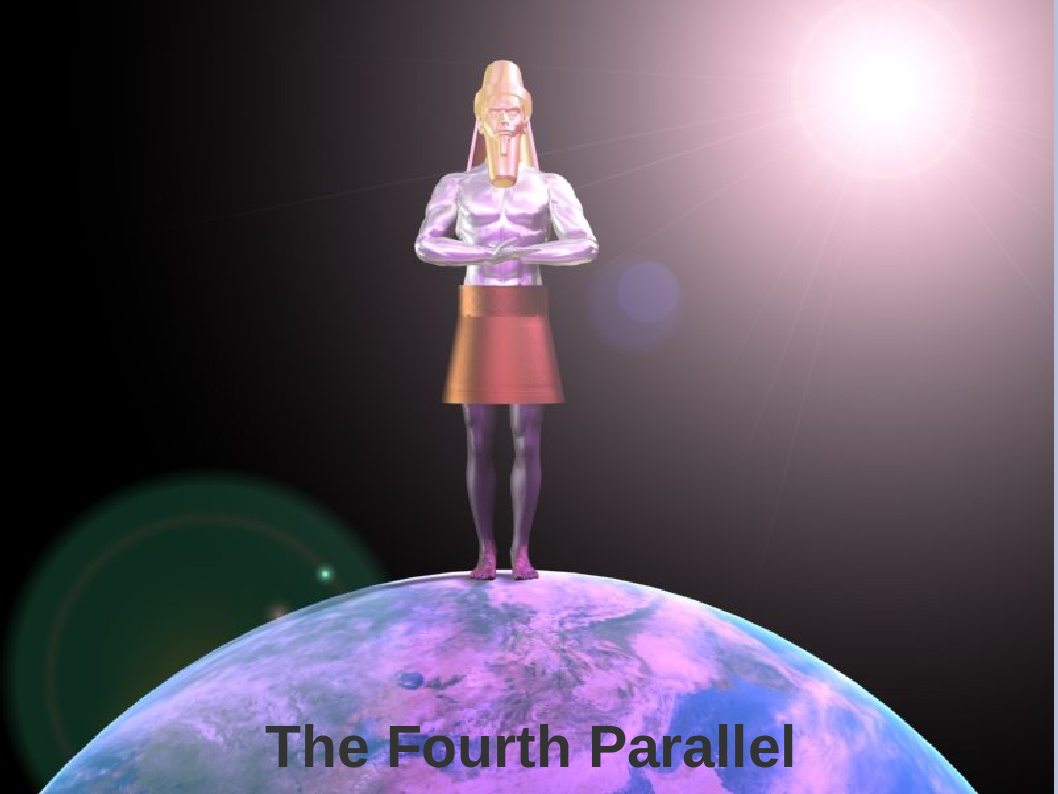
The book of Daniel is an important sign for our time. It contains information which provides evidence of YHVH’s existence, that He is involved with His creation. The book outlines the entire course of events starting from Daniel’s time which will bring this age to an end.
The prophecy given in Daniel 8 has been misinterpreted and used to produce corrupted ideas or “Doctrines”. One such doctrine states that something of note happened in 1844. An American christian, William Miller originally used Daniel 8 to predict that Yeshua (Jesus) would return in 1844. When this failed to happen those of his followers who refused to let go of the error, as William Miller himself did, went on to produce a doctrine based on the 1844 date.
It is important that we understand prophecy as best we can, even though knowledge of prophecy will not save us. YHVH has given us messages through the prophets in the scriptures and, aside from the fact that they inform us, they provide important evidence when talking to others about Him. When Moses was first given his mission (which he accepted) to save the people of Israel his response was:
…behold, they will not believe me and will not listen to my voice. For they will say, Jehovah has not appeared to you. (Exodus 4:1 [LITV])
Moses was given evidence to show the people of Israel that what he said was true (1) His staff turned into a serpent (Exodus 4:2-4); (2) His hand turned leprous (Exodus 4:6-7).
In a similar way the prophecies of Daniel are signs of proof for we who are near the end of time, telling us the history and conclusion of the powers of this world, and that ultimately YHVH is in control. If we allow obvious errors in our interpretation of Daniel’s prophecies to stand, we do YHVH a mis-service and foster disbelief in the minds of those who recognise inconsistencies in what we say.
The Dream of a Metallic Statue
In Daniel 2 the king, Nebuchadnezzar had a troubling dream, which YHVH reveals, with the interpretation, to Daniel to tell the king.
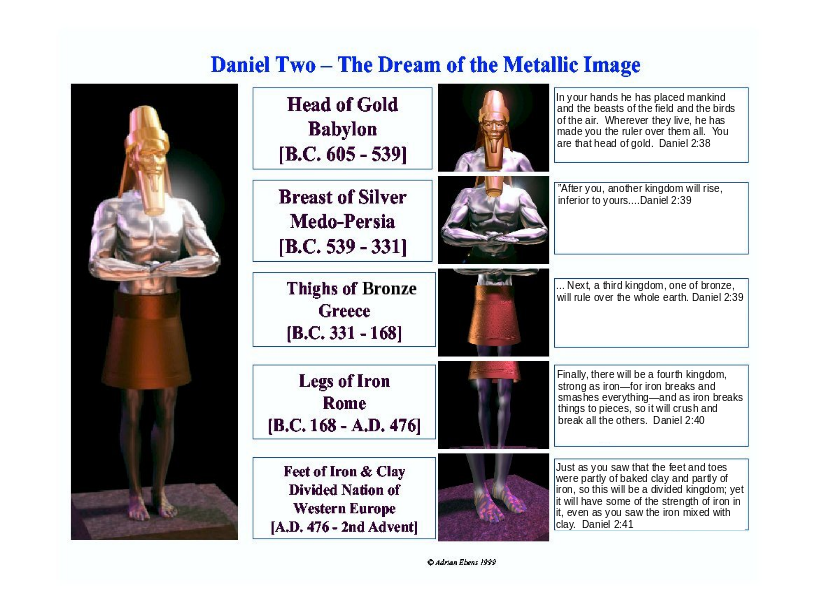
Daniel’s task was not as simple as just interpreting the King’s dream. The King wanted to be sure that his wise men were not just making things up, so not only did they have to interpret the dream, they also had to tell him what the dream was – without any help from him! (Daniel 2:1-25)
With YHVH’s help Daniel tells the king that his dream was about a statue with a head of gold, breasts of silver, belly and thighs of bronze, legs of iron and feet made of iron and clay. An invisibly cut stone hit the image on the feet and broke them to pieces. Then the iron, clay, bronze silver and gold were reduced to dust and (Daniel 2:26-35).
Daniel explains that the head of gold represents the king’s dominion and that there will follow four lesser kingdoms represented by the breast of silver, thighs of bronze, legs of iron and finally feet of iron mixed with clay. Daniel went on to say that in the days of the last kingdom, YHVH would set up His kingdom which would destroy all the others and stand forever. In summary Daniel tells the king that YHVH, with the dream, has told him the entire future of the world.
As Daniel recorded this story for us we can now recognise the history of the world powers, and know its future too, but at the time only the power which represented the head of gold was known. Daniel told the king and the empire he ruled was the head of gold (Daniel 2:37-38). It is only with subsequent information given in Daniel, and also historical record that we know the identify of the other powers represented by the different parts of the statue made from different materials.
Five World Powers
The three visions in Daniels writings when taken together provide us with a picture of the significant world powers’ progression through history: From Babylon (605 BC) to the present day. The first two visions are represented in the following diagram:
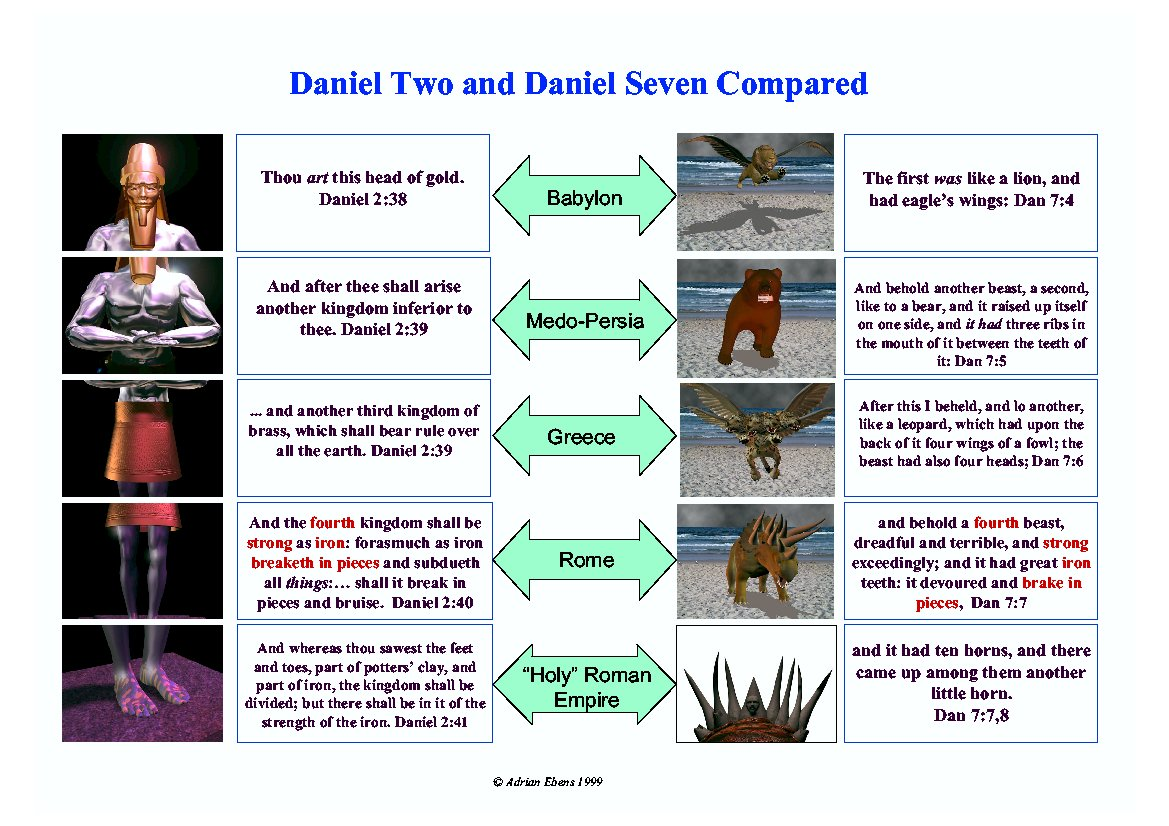
Using today’s knowledge of history we know that the first world power was the Babylon (605 – 539 BC). After this came the Medo-Persian empire (539 – 331 BC). The Persians came to dominate the Medes. This empire defeated the three powers of Lydia, Babylon and Egypt. After this came the Greek empire forged by Alexander the Great (331 – 168 BC). Alexander died very young and his empire was separated among four of his generals. The next power was the Roman empire (168 BC – 476 AD), the longest lived empire. The empire finally separated into ten regional kingdoms. Papal Rome removed three of these and enjoyed a wide influence in world dealings. The Roman empire is considered here to have two phases. The first was Imperial or Pagan Rome, and the second was Papal Rome.
Only Babylon was named in the first vision (Daniel 2:38), we are then given the names of the second two in the third vision (Daniel 8:20, Daniel 8:21). Using this information we can create a diagram which compares all three vision. This is a pictorial visualisation of what is called the “Parallelism Principle” in Bible exegesis, where different passages or concepts can be found to have the same patterns of meaning.
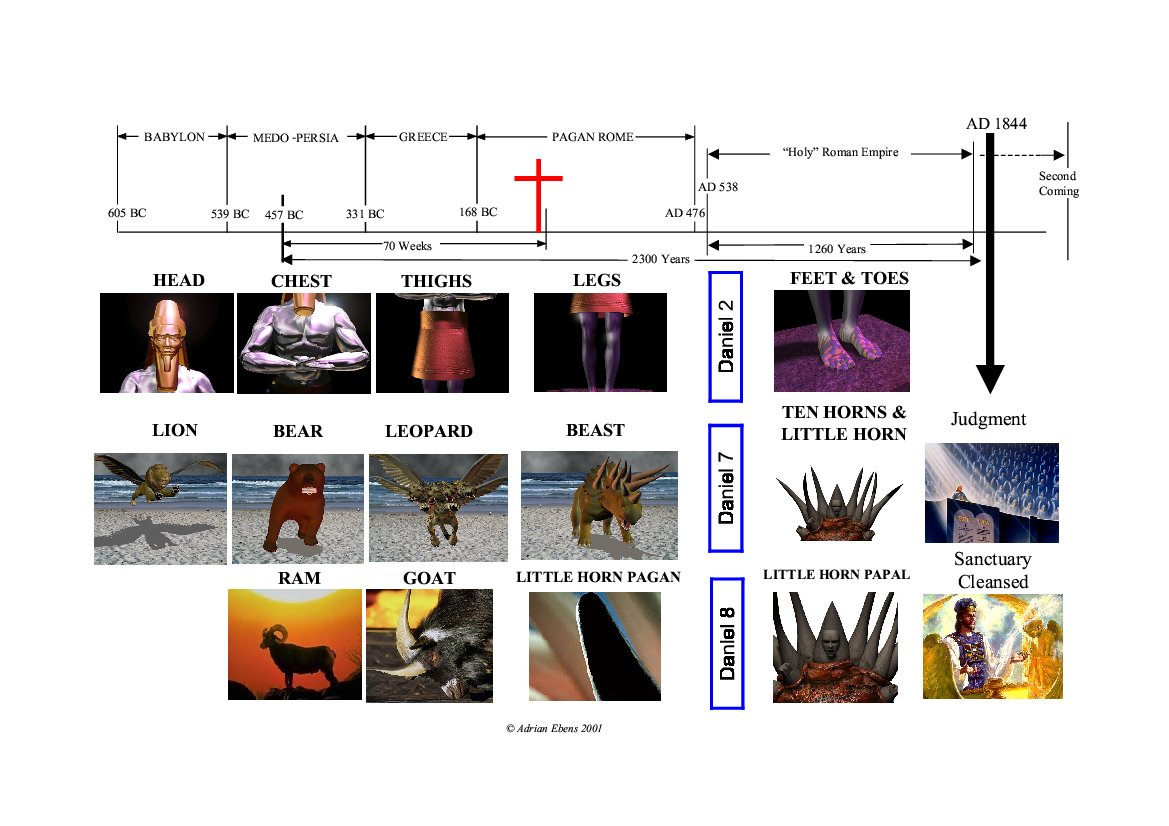
The above diagram shows one particular interpreted of Daniel’s visions. In this article we are concerned primarily with the first four “Parallels” which correspond to Babylon, Medo-Persia, Greece and the Pagan Roman empires which date from 605 BC to 476 AD.
(Now would be a good time to read through Daniel 8, if you have not done so already)
The Author Defines the Key
In understanding Daniel’s visions we must accept the keys and relationships provided by the author. Who is the author in this case? It is YHVH. It was Daniel who wrote everything down, but it was YHVH who provided the material; the visions. YHVH is consistent as an author. He doesn’t make mistakes, contradict Himself nor present us with confusion. So when YHVH as the author provides us with the key to understand His communication with us, then we would be foolish not to use it.
In the visions written down by Daniel power is the key. Each power described has consistent characteristics:
- They are associated with a specific categorisation or entity (a material or beast).
- They emerge from a specific people (national group).
- The visions describe the kingdom transitions – whether they are by external or internal powers.
- The powers have control of YHVH’s people (sanctioned by YHVH).
Bearing this in mind, those with a systematic eye will notice immediately that there is an inconsistency in the line for the Daniel 8 vision: the “Little Horn” depicted in the vision (Daniel 8:9) is shown as corresponding to the legs of the Daniel 2 vision (Daniel 2:33) and the beast of the Daniel 7 vision (Daniel 7:8). This is the fourth parallel and represents the Pagan Roman empire. This will be discussed below in more detail.
The First Parallel
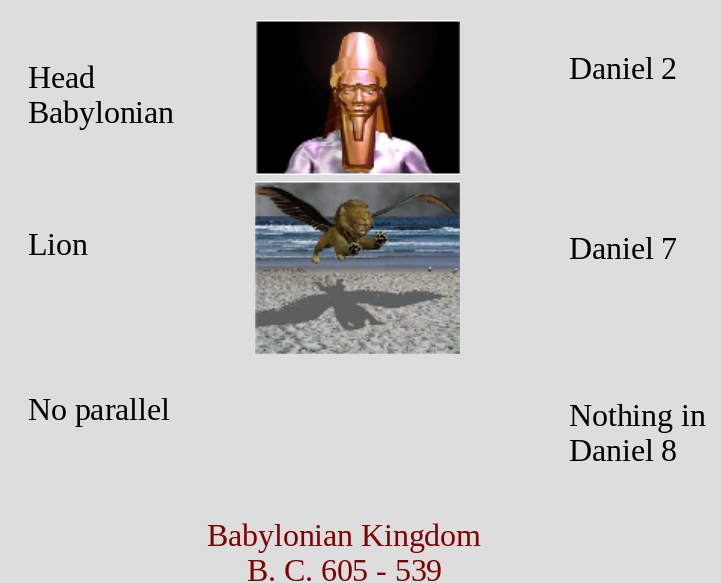
The first parallel grouping corresponds to the Babylonian Empire which was in present-day Hillah, Iraq (605-539 BC). It is represented by the head of gold (Daniel 2:32) and a lion (Daniel 7:4). This is the first kingdom, and the only one named until the vision in Daniel 8. There is no reference to Babylon in the Daniel 8 vision, which is not unexpected, as Daniel had the vision towards the end of the Babylonian empire, when Belshazzar was ruling Babylon (Daniel 8:1). The killing of Belshazzer brought the Babylonian Empire to an end (Daniel 5:30).
The Second Parallel

The Medo-Persian Empire (539-331 BC) is represented by the second parallel. This empire completely replaced the Babylonian power. In the visions it is represented by the chest and shoulders of silver (Daniel 2:32), bear (Daniel 7:5) and the ram (Daniel 8:3). It is in the Daniel 8 vision that we are given the name of the second empire (Daniel 8:20). There is more detailed information in the representations of the Medo-Persian Empire; the bear is described as having two distinct sides and the ram had two horns, this empire was primarily composed of two nations, the Medes and the Persians. Later the Persians came to dominate the Medes as indicated by the bear being raised up on one side (Daniel 7:5) and also one of the rams horns being higher than the other (Daniel 8:3). We can also see that the three powers defeated by the Medo-Persian Empire: Lydia, Babylon and Egypt are represented by the three ribs in the bear’s mouth (Daniel 7:5).
The Third Parallel

The third power is named in Daniel 8:21 as Greece (331-368 BC). The Greek empire is represented by the belly and thighs of bronze (Daniel 2:32), the leopard with four wings and four heads (Daniel 7:6) and the goat with a big horn which was then broken and replaced by four horns (Daniel 8:8). The Greek empire lead by Alexander the Great replaced the Medo-Persian power. Flavius Josephus reports that when Alexander the Great came to Jerusalem, he was welcomed in Jerusalem and shown the prophecy of Daniel which predicted his coming (Josephus, Antiquities of the Jews, Book 11, chap. 8, sec. 5, William Whiston translation, 1981). However, Alexander the Great died very young at the height of his power, and his Empire was eventually divided among four of his generals. This fourfold division is represented by the four heads of the leopard, and the four subsequent horns of the goat.
The Fourth Parallel

The name of the fourth power corresponding to the fourth parallel, was not given in any of the three visions, but from history we know that the Greek Empire was replaced by the Imperial or Pagan Roman Empire (168 BC – 476AD). It is represented by the legs of iron (Daniel 2:33) and the unspecified beast (Daniel 7:7). Note that in the above diagram there is no fourth parallel for the Daniel 8 vision, unlike in the previous diagrams that show a horn or the “little horn”. It is the misinterpretation of considering the “little horn” of the Daniel 8 vision (Daniel 8:9-12) as representing a fourth nation power that is the focus of this article.
Consistently following the key given by the author leads to the understanding that the vision of Daniel 8 only refers to two powers, both of which are named in the vision. For this to be otherwise another animal would be required in Daniel 8 for Rome. We are told that the four new horns in the vision represent four kingdoms coming from the same nation, Greece (Daniel 8:22). We are also told that the little horn in the vision appears, “In the latter part of their reign” (Daniel 8:23), referring to the latter part of the reign of the four kingdoms. This dates the little horn’s action as being towards that end of the Greek power, and not after as would be required for a description of the Roman Empire which replaced the Greek Empire. We also know that the little horn is connected to one of the four preceding horns. This maintains the physical integrity of the image; you can have a horn growing out of another horn, but it being disembodied would probably be recognised as something else entirely: We must remember to visualise what Daniel would have seen and comprehended. What this means is that the little horn could not come “out of the wind”, as is suggested by some.
The Fifth Parallel

The fifth parallel in both the Daniel 2 and Daniel 7 visions can be seen to represent a continuation of the previous Empire, but in a different form. For the Daniel 2 vision, the fifth power is shown to contain iron, as for the previous empire, but now it is mixed with clay. In the Daniel 7 vision, the focus is on the horns, but again they are still connected to the beast corresponding to the previous empire.
Parallelism in Daniel’s Visions

The above diagram shows how Daniel’s visions should be interpreted. It is important to follow the key given by the author, YHVH: Each category represents a different power:
- In the vision of Daniel 2, each empire was represented by a different part of the statue, which were also made of different materials.
- For the vision of Daniel 7 the different powers were denoted by different beasts.
- Different animals represented the different powers in Daniel 8.
Conclusions
The vision of Daniel 8 only describes two powers – there is no fourth parallel. For Daniel 8 to describe more than two powers, a third animal would have been introduced. This interpretation is consistent with YHVH’s use of imagery in the rest of Daniel and the rest of the Bible. It is disingenuous for us to try and force an interpretation of the vision that does not fit with the key provided. Therefore, Daniel 8 depicts events with time prophecies that are completed within the vision’s description. This means that the events of Daniel 8 occur before the onset of the Roman power, and the time period mentioned in Daniel 8:14 (the 2300 evenings and mornings) cannot be applied beyond the end of the Greek Empire (see article “A Question of Time” regarding the 2300 evenings and mornings prophecy – coming soon).
Acknowledgements
The diagrams are revised from pictures, used with permission, from Adrian Ebans, http://maranathamedia.com.